For context, you may find it useful to read previous articles on supersymmetry first (this one, and this one, and this one) before reading this article, which assumes you have the knowledge they contain.
A common variant of supersymmetry is called “gauge-mediated supersymmetry breaking”. What is important for our purposes is that this is an example of a theory that violates assumption 2 of the classic three assumptions of the most popular form of supersymmetry, which are
- in any process, the number of superpartners can only change by an even number;
- the lightest superpartner [which is stable, by assumption 1] is a superpartner of a particle we know (and therefore, to avoid conflict with other data, an undetectable neutralino or sneutrino);
- the superpartners that are affected by the strong nuclear force are significantly heavier than the other superpartners of known particles.
The gravitino — the superpartner of the graviton — is so light in this theory that the lightest superpartner of a Standard Model particle will decay to it — and we may see signs of this decay in our detectors. In the following I will clarify this remark, and look at how experimental searches at the LHC constrain this version of supersymmetry.
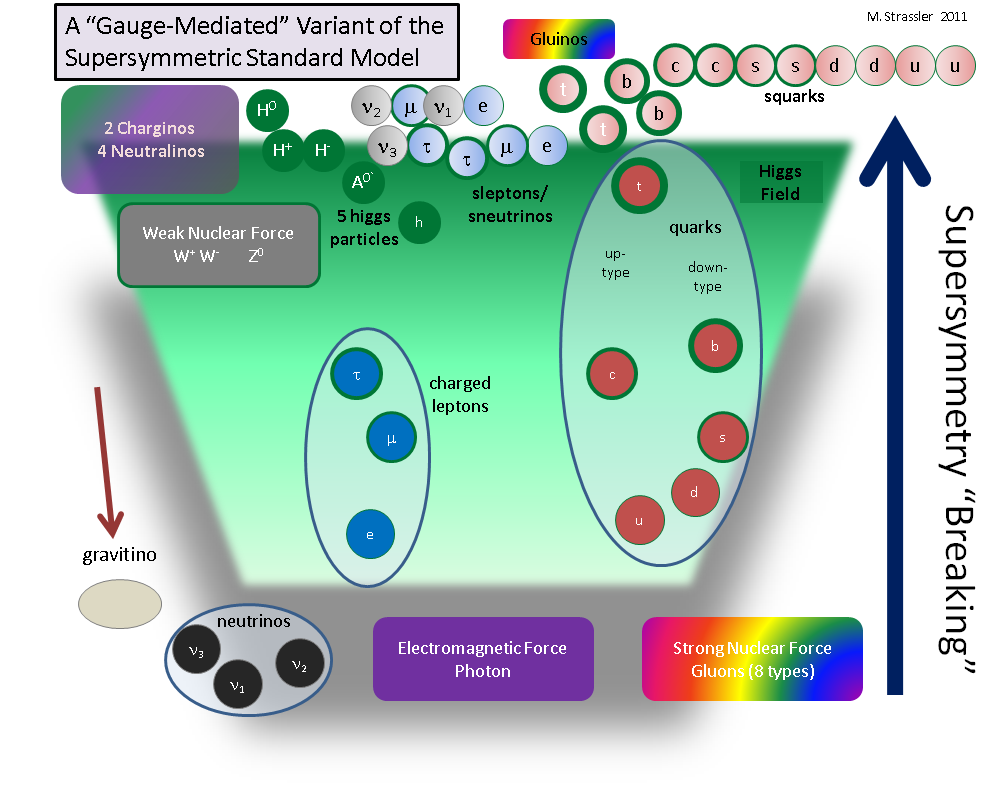
One of the most popular versions (but as usual, not the only one) of this variant of supersymmetry puts the superpartner masses as shown in Fig. 1. This is almost the same as Fig. 3 of this article on the classic version of supersymmetry, except that there is a gravitino that is very light.
Production and decay of supersymmetric particles is almost the same as it is in the classic version of supersymmetry — heavy squarks and gluinos are produced, and decay to high-energy quarks and gluons, leading to “jets” of hadrons — but instead of the classic “missing energy” from undetectable stableneutralinos, shown in Fig. 2, something more spectacular happens: each neutralino decays to a gravitino and something else: a photon, a Z particle, or a Higgs particle. This situation offers many new possibilities for what one might see in the LHC detectors, but in this article I’m going to focus on the three shown in Figs. 3, 4 and 5.
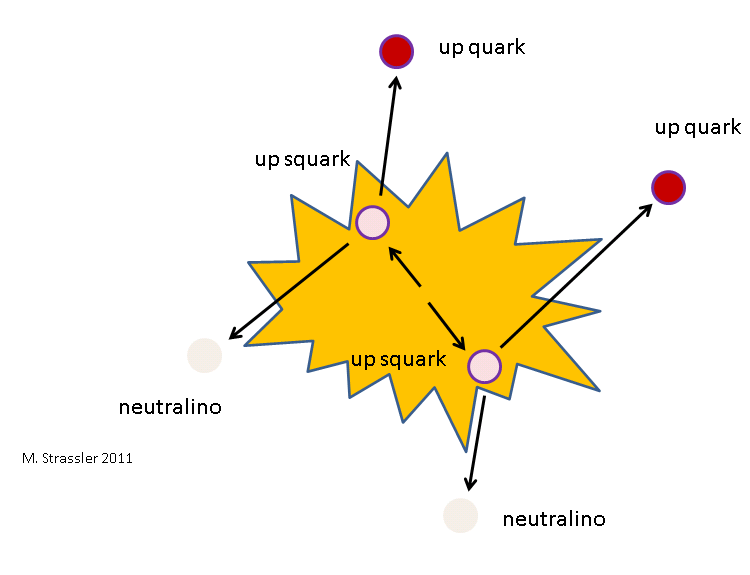
If nature has a variant of supersymmetry that commonly produces the process shown in Fig. 3, then the experimentalists will detect collisions that produce two photons, signs of something undetectable (“missing-energy”) from the gravitinos, and high-energy jets of hadrons [in the particular case shown in the figure, two] from any quarks or antiquarks running about. They then have a relatively simple task, because medium-to-high-energy photons are rarely produced in ordinary proton-proton collisions, and it is even more rare that they are produced at the same time as a lot of missing energy. All the experimentalists need do is look for an excess of events, beyond those expected in the Standard Model of Particle Physics, that have two photons along with some “missing energy” that suggests the presence of the two invisible gravitinos.
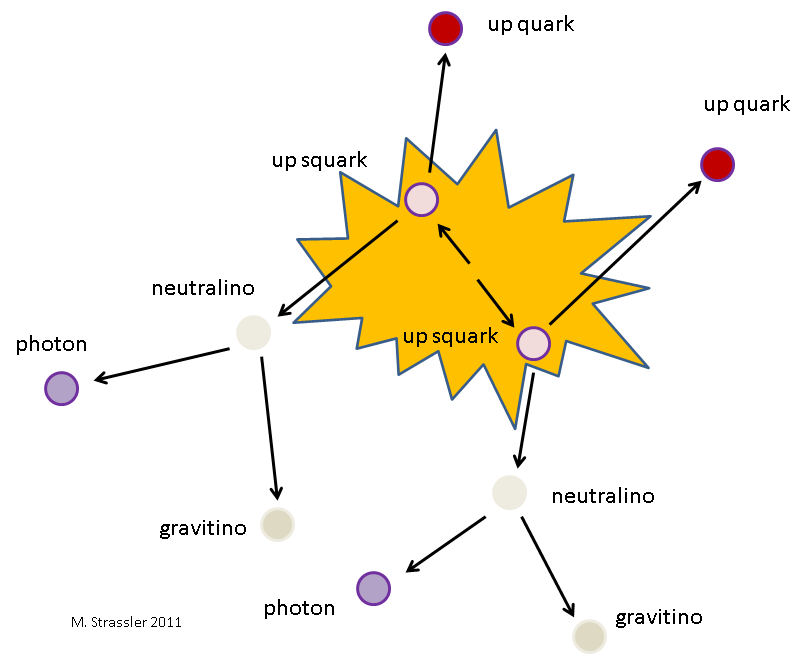
A search of this type was recently done by the CMS experimental collaboration. Nothing was found — and for this to be the case, the heavy superpartners in this model would have to have mass-energy of nearly 1 TeV. In short, this particular variant of supersymmetry is just about as constrained as is the most popular version. It is unlikely that this is a model of nature.
But another possibility is that the neutralinos do not decay to photons, but instead to decay to Z particles, as shown in Fig. 4. Z particles are not as easy to detect. About 3% of Z particles decay to an electron and an anti-electron, and another 3% decay to a muon and anti-muon. Muons and electrons (and their antiparticles) are easily detected, and from the details of their energies and directions of motion, one may infer that they came from a Z. But many Z particles decay to undetectable neutrinos; and still more decay to a quark and an anti-quark, giving two jets of hadrons that are not easily identified as stemming from a Z particle. In short, whereas almost every photon can be detected and identified for what it is, this is true for only about 6% of Z particles.
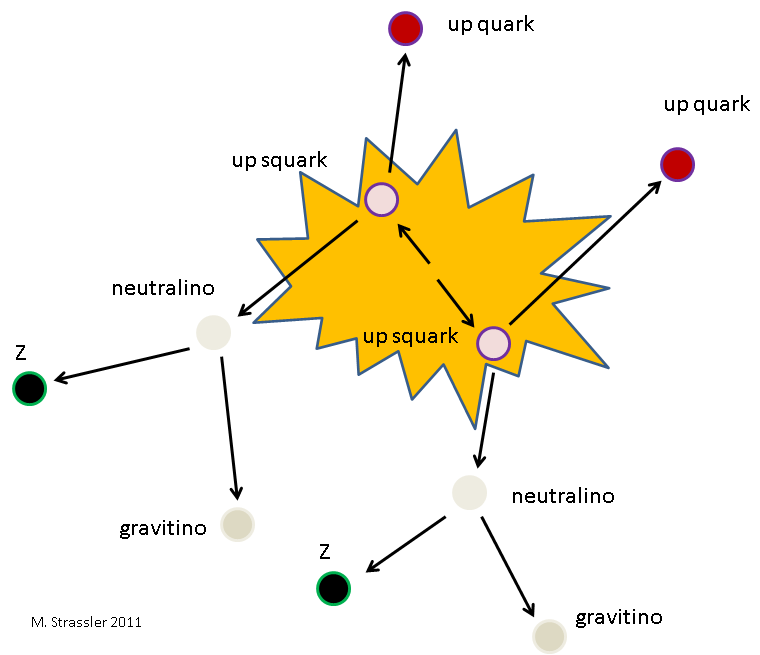
You might then infer that the limits on this type of model are much weaker than in the case where the neutralinos decay to photons, and you would be right. Limits on this case have not been published by the experimenters, but my Rutgers faculty colleague David Shih, along with Rutgers postdoc Yevgeny Kats, Harvard postdoc Matt Reece and Stonybrook faculty member Patrick Meade, have looked into this. Considering a very nice CMS search for a Z particle (decaying to electron/antielectron or muon/antimuon), plus jets, plus missing energy, as would arise from the process in Fig. 4, they conclude tentatively (this is work that was reported publicly at the Supersymmetry 2011 conference but has not been published) that limits on the heavy superpartners are only around 600 GeV in this case. In other words, this variant of supersymmetry is not yet highly constrained by the data.
Photons are relatively easy, Z particles are somewhat harder, so models (supersymmetric or not) that produce the latter are not as quickly excluded compared to those that produce the former. This is a general lesson.
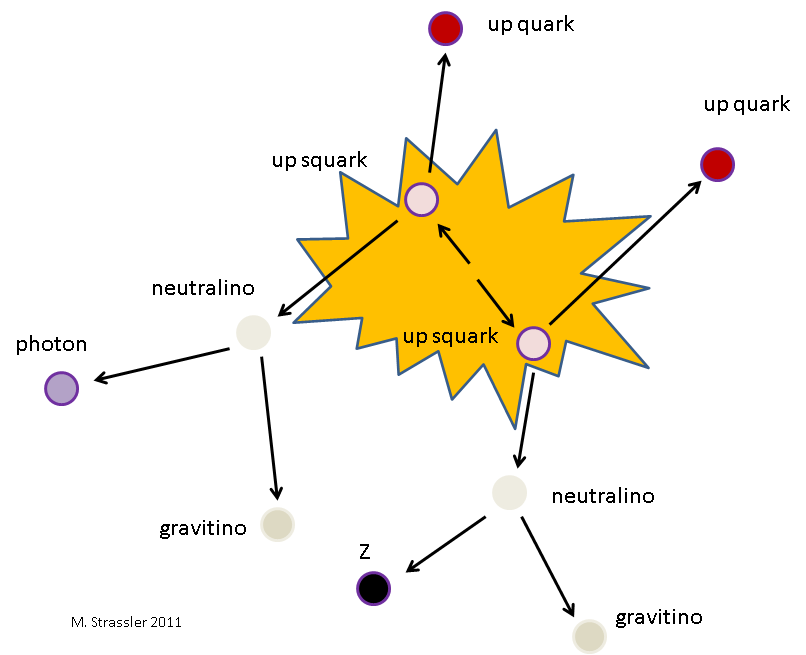
It is also possible that (a) collisions that make photon pairs are very rare, and (b) collisions that make Z particles that decay to leptons are rare, but (c) collisions that make a photon and a Z particle are not so rare. Even if the Z particle decays to undetectable neutrinos, or to jets from a quark and an anti-quark, the photon can still be identified. So CMS carried out a search for events with a single photon, jets and missing energy. This search puts additional significant constraints on these classes of models, though the details are complicated to describe.
Although these beautiful experimental searches — for two photons, for one photon, or for a Z particle (decaying to a charged lepton/antilepton pair), plus jets from quarks, antiquarks or gluons, plus missing energy from undetectable particles — were aimed at a particular version of supersymmetry, they hit many other targets as well. This is always the case at the LHC; a search motivated by one model or class of models is useful for restricting many other classes as well. The implications of the searches described here, both for other variants of supersymmetry and for entirely unrelated non-supersymmetric models, have still not been carefully explored, but it is clear already that they are significant.
[This webpage has benefited from conversations with Yevgeny Kats, Philip Schuster, David Shih and Natalia Toro.]


2 Responses
Buying a used car can be tricky, no matter how much you already know about
cars. There are lots of different things to consider so that you don’t end up buying a piece of junk that breaks down right away. Use some great tips of the trade in the following article to help you make your next car choice.